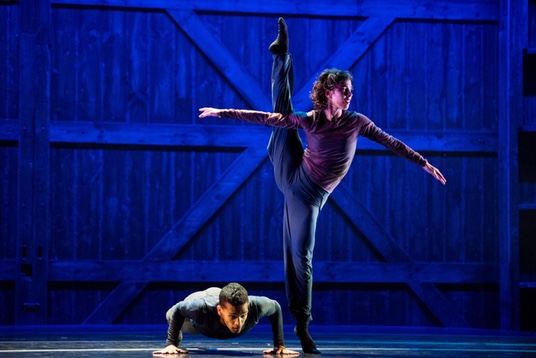Sat 2/27
From where we sat on the main level, the Ohio Theatre was packed on Saturday night for Malpaso, a dance company from Cuba on its first stop in an eleven-city tour. This was Malpaso’s first time in Cleveland but not their first North American tour; in 2014 they won popular and critical acclaim at the Joyce Theater in New York City among other venues.
Nor was it the first cultural commerce between our two nations. To name one well-known example, jazz man Dizzy Gillespie’s collaborations with Cuban percussionist Chan Pozo go back to 1947, before the revolution. Since the revolution, Ballet Nacional de Cuba has furnished a steady stream of talented, well-trained defectors even as North American critics label that company’s repertoire old fashioned.
In 2011 Danza Contemporánea de Cuba, long considered Cuba’s foremost contemporary dance company, performed in the U.S. and won praise for its dancing even though U.S. critics considered its repertoire old-fashioned. Arturo O’Farrill and his band, the Afro Latin Jazz Ensemble, have travelled frequently to Cuba and were in Havana working on an album when President Obama announced his initiative to normalize relations; the album, Cuba: the conversation continues, includes Afro Latin Jazz Suite, which won O’Farrill the 2016 Grammy award for best instrumental composition. So, cultural commerce, the conversation, between Cuba and the U.S. goes way back, persisted through political differences, and holds forth great promise.
Both of the ensemble works in Saturday’s concert were showcases for collaboration between Cuban and U.S. artists.
One piece, por que sigues (Why you follow) (2014), commissioned by the Joyce Theater, was created on the Malpaso dancers by Ronald K. Brown, a New York-based African-American choreographer known for his ability to incorporate traditional West African movement into a contemporary concert dance format. Working from recorded Afropop and other African-influenced world music, Brown gave eight of the sleek Malpaso dancers a 23-minute workout of rolling rhythms. Lighting by Clifton Taylor and costumes by Keiko Voltaire, both mainstays of New York dance and theater, added a high sheen to the piece.
In the other ensemble piece, 24 horas y un perro (24 Hours and a Dog), Malpaso’s Founder, Osnel Delgado Wambrug, choreographs to O’Farrill’s commissioned composition, 24 Hours in a Dog’s Life, performed live in the pit by O’Farrill and his band, the Afro Latin Jazz Ensemble. A suite of Latin dance rhythms, O’Farrill’s music alone was worth the price of admission.
In 24 Hours and a Dog, Delgado’s stated intention is to depict a day in the life of his dancers “as they are dogged by an imaginary dog.” Accordingly, we see lights come up on an empty stage and Delgado walking on and limbering up alone. As the dance continues, the dancers move rhythmically, yes, but there’s also a lot of stopping movement before the music is finished and lots of walking around out of time, especially by Delgado, who seems to be acting out his role as choreographer. The imaginary dog is seldom out of mind as the dancers adopt quadrupedal positions, especially (ahem) Downward Dog and 3-Legged Dog, also known as the fire hydrant position.
Both Why you follow and 24 Hours and a Dog maintained interest and even grew on us as they progressed, an achievement for plotless works without obvious crescendos.
Also on the program —Ocaso (Twilight) (2013), a duet choreographed by Delgado and performed by Beatriz Garcia Diaz and himself to recorded music.
But our descriptions have completely left out the pleasure of keeping company with Malpaso and the Afro Latin Jazz Ensemble, pleasure which brought the audience to its feet clapping and calling out loud bravos. Malpaso’s first steps in North America are no missteps but strong and confident, buoyed up by capable U.S. collaborators.
[Written by Elsa Johnson and Victor Lucas]
